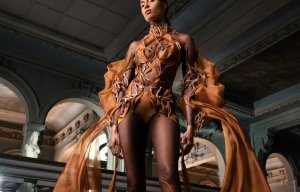
Haute couture from cocoa bean husks
Marie O’Mahony interviewed Iris van Herpen and Philip Beesley at the opening of their exhibitions ‘Iris van Herpen: Transforming Fashion’ and ‘Philip Beesley: Transforming Space’ at the Royal Ontario Museum, Toronto, Canada.
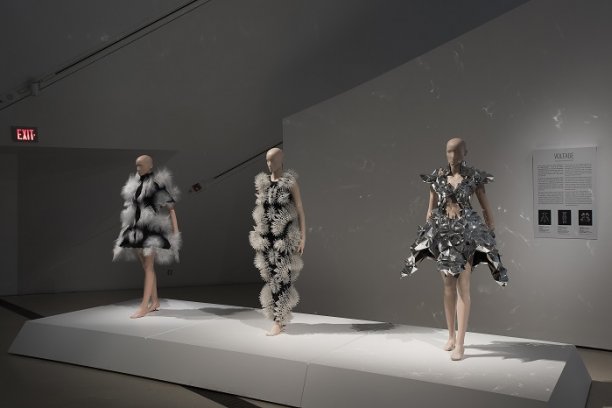
13th June 2018
Innovation in Textiles
|
Toronto
Marie O’Mahony interviewed Iris van Herpen and Philip Beesley at the opening of their exhibitions ‘Iris van Herpen: Transforming Fashion’ and ‘Philip Beesley: Transforming Space’ at the Royal Ontario Museum, Toronto, Canada.
In the work of Iris van Herpen we see technology become a vital part of Haute Couture. Intricate lace and embroidery feature strongly, but the designer is working with an array of collaborators from technologists to architects and artists – often reading like a Who’s Who in their respective fields. One of her most frequent collaborators is the artist and architect Philip Beesley.
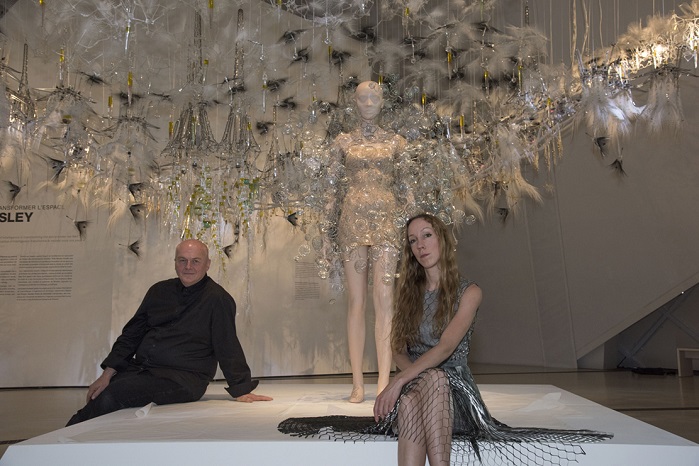
Iris van Herpen was first inspired by Beesley’s work when she visited his exhibit for the Canadian Pavilion at the 2010 Venice Biennale. His work served as inspiration for her subsequent collection Hybrid Holism (July 2012), with the first actual collaboration coming shortly after in van Herpen’s Voltage (January 2013) collection. As the title suggests, the collection comes from ideas around how electricity behaves within the body and externally, considering its transformative powers in each case.
The inspiration for the collection came from the New Zealand artist Carlos van Camp, known for his experiments with the Tesla Coil. He worked with the designer developing a choreography with very high-voltage instruments designed to interact through the movements of the performer. Van Herpen’s work with Beesley in this collection was in the development of 3D fabrics to bring form to the concept in garments designed to respond to the wearer’s body movement through dynamic vibration.
In early 2014 Iris van Herpen and Phillip Beesley travelled to Switzerland to see the Large Hadron Collider (LHC) at the European Organisation for Nuclear Research, CERN. The magnetic field is 100,000 times more powerful than the Earth’s. The LHC has a ring of superconducting magnets measuring 27-kilometres with 1,232 dipole magnets used to bend the beams and 392 quadrupole magnets to focus the beams. Fascinated by this interplay of attraction and repulsion, the visit led to van Herpen’s Magnetic Motion Collection (September 2014). The designer describes finding “beauty in the continual shaping of chaos, which clearly embodies the primordial power of nature’s performance.”
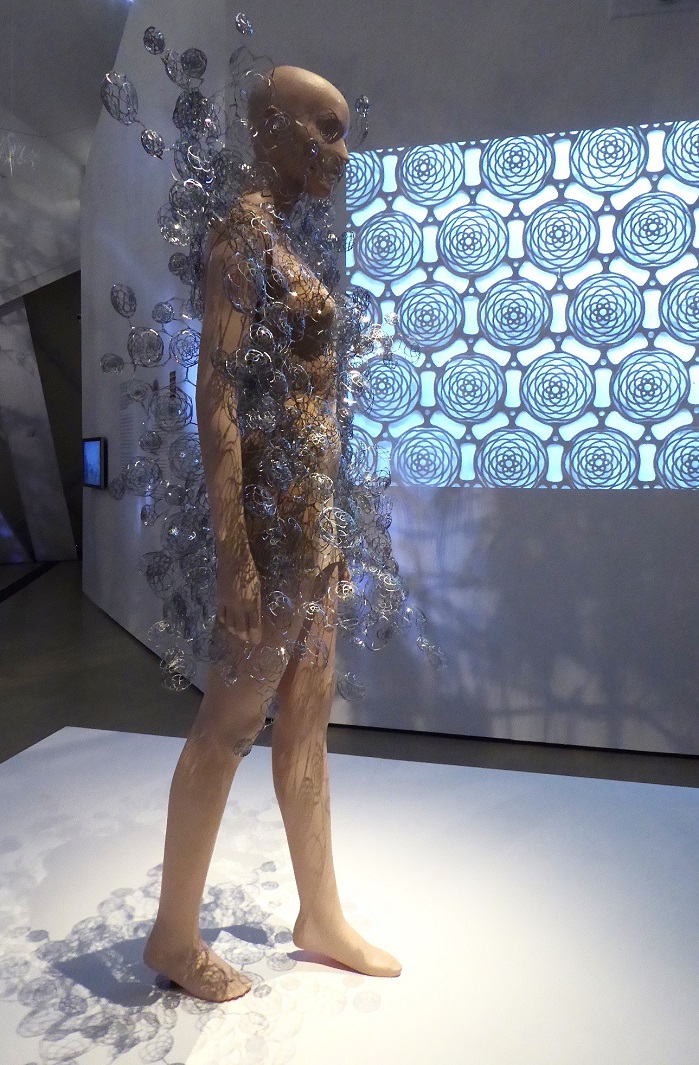
One of Iris van Herpen’s great skills is in working with a multitude of materials, processes and collaborators within a single collection. In Magnetic Motion she uses acrylic, silicone chevrons, goat leather and viscose employing hand and machine techniques such as laser cutting and 3D printing. Collaborating with Philip Beesley on some of the garments, she also worked with the Dutch artist Jolan van der Wiel to create shoes for the collection using iron filings and a polyurethane resin.
Referring to the CERN experience, Philip Beesley comments that watching the scientists at work was for him the “absolutely embodied working with your hands.” His observation goes some way to explaining the apparent ease with which van Herpen brings together technology and craft. She sees technology as something to be mastered over time, much like a traditional craft or akin to mastering a musical instrument: “it does take time, because the thing when I was working with 3D printing the process is very different, so it influences you, but I think that you always need to get to know your instrument. After a time, you guide the instrument rather than the other way around. That’s a tipping point that you need to go to and then there is no difference any more in the process.”
Iris van Herpen is fascinated by immateriality that brings her to ask the rhetorical question “where does something become material and where does it not?” In cooperating and collaborating with people outside conventional fashion and textiles the different working processes can point to some quite unique outcomes. Describing her working process as “quite intuitive, almost subconscious”, van Herpen goes on to say how “much of it is trial and error”. Perhaps most tellingly: “for me the process is more important than the outcome; trying new technologies and materials these concepts come to me quite naturally”.
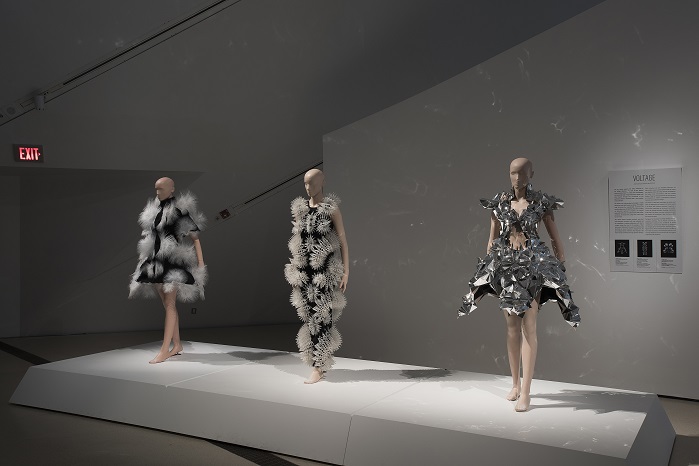
Working as she does directly onto the mannequin contrasts sharply with the architect’s use of hand sketches and digital renderings. The Royal Ontario Museum (ROM) in Beesley’s native Toronto acquired the Dome dress from Iris van Herpen’s Aeriform Collection (Autumn 2017). The dress is the most recent collaboration between the two and the museum also commissioned a documentary by fashion filmmaker and art director Stylianos Pangalos to accompany the work that is currently showing at the museum. In it we are shown both synergies and differences so that for instance the making of the dress involved two hundred and forty hours of handmaking, contrasting with sixty-two hours of machine making.
The collaboration between the two is the subject of interconnected exhibitions showing at the ROM in Toronto until 8 October: Iris van Herpen: Transforming Fashion and Philip Beesley: Transforming Space. The exhibition is co-organised by the High Museum of Art in Atlanta and the Groninger Museum in The Netherlands who, along with the designer herself have lent many of the pieces for the show from their collection. The Dome Dress is situated in the space where the two exhibitions meet. It sets about examining the nature and anatomy of air, with the idea of communicating an airborne materiality. Metal, the heaviest of materials is used to create laser cut discs structures that are then shaped into a series of dome forms by hand to create a gossamer-thin biometric form. The result is more lace than metal as the designer sees it very connected to the traditional idea of a textile.
Much of the current focus of digital tools is centred around Industry 4.0, linking machines for better and for faster production. But this body of work is a reminder of its potential in the creative process, in developing new forms of craftsmanship and in exploring a new hybrid materiality. In the hands of van Herpen and her collaborators the digital has become a tool to help realise dreams.
“I think that the digital process can really help in realising some of the most impossible things” says the designer who then goes on to say, “like the model for the Aerofoil dress, I think that it really helped to achieve the intricate delicacy. The relationship between the digital and the materiality is such a natural one, I don’t even divide them anymore”.
Marie O’Mahony is an industry consultant, author and academic. She is the author of several books on advanced and smart textiles published by Thames and Hudson and Visiting Professor at the Royal College of Art (RCA), London.

Business intelligence for the fibre, textiles and apparel industries: technologies, innovations, markets, investments, trade policy, sourcing, strategy...
Find out more